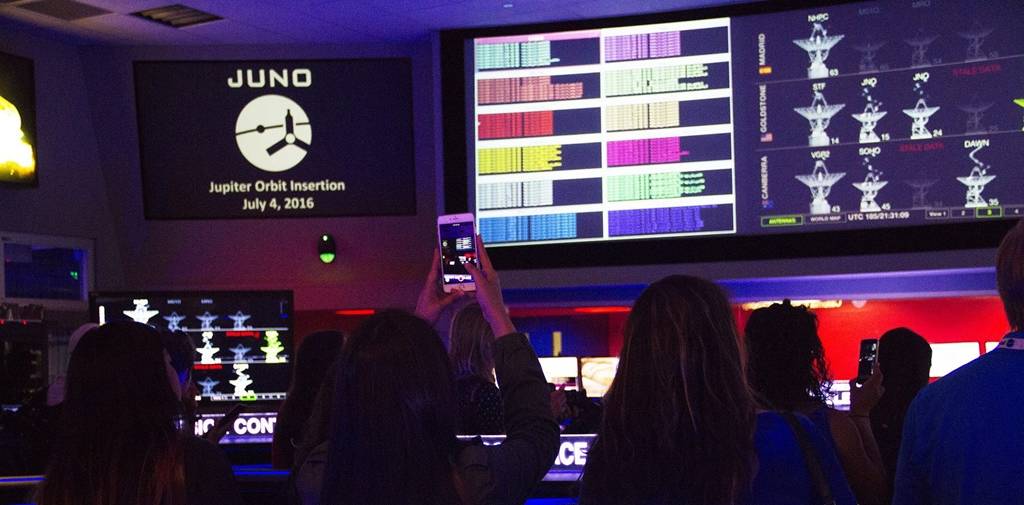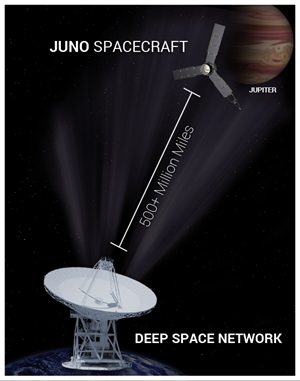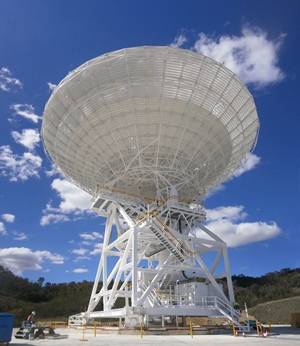
After entering orbit around Jupiter, 540 million miles across the solar system, Junos first message took 48 minutes to send and then the monitors in mission control at NASA's Jet Propulsion Laboratory flashed, Welcome to Jupiter. (Photo Credit: NASA)
The Juno spacecraft successfully entered orbit around Jupiter on July 4, 2016 and a series of large antennas located in Australia and California were online, tracking and receiving data as Juno made history. These large antennas known as deep space stations connect with communication facilities to form NASA's Deep Space Network. This network provides vital, two-way radio contact for NASA's mission teams and scientists to communicate with spacecraft like Juno.

Helping make space communication possible is where engineers at General Dynamics Missions Systems come in to play. We not only design and build antennas like deep space station 35, we also work with the NASA's Jet Propulsion Laboratory to design and build transponders for spacecraft that facilitate X-Band and Ka-Band telecommunications. Using our small deep space transponder, the Juno spacecraft has already begun sending high-resolution color images to NASA and scientists in order to show the planets atmosphere, including the famous Great Red Spot.
Connecting Spacecraft Beyond Our Galaxy
NASA's Deep Space Network is an international array of radio antennas and communication facilities that supports interplanetary space exploration and provides radar and radio astronomy to help improve our understanding of the solar system and universe. Comprised of three complexes around the world (California, Spain and Australia) which are 120 degrees apart, the Deep Space Network keeps NASA constantly connected with its spacecraft as the Earth rotates. In fact, the Deep Space Network is the largest and most sensitive scientific telecommunications system on earth.
NASA is in the process of upgrading the Deep Space Network to better support future space exploration missions. Our SATCOM Technologies division recently finished construction, installation and testing of two new beam wave guide antennas as a part of NASA's modernization plan. The antennas use a new servo-control system to more accurately position and point each antenna, improving communication and tracking of space exploration missions from Mars to beyond our galaxy. These precision scientific instruments can pinpoint a location in the universe billions of miles from Earth while connecting scientists with space probes that have left our solar system like Voyager 1.

Each antenna is the width of a football field and weighs about 500 tons. They are built to withstand extreme weather conditions like heat and high winds to ensure the antenna holds its pointing position to within the width of a human hair. In collaboration with the Jet Propulsion Laboratory, our engineers have designed, built, and delivered nine new 34-meter antennas for the Deep Space Network and have helped upgrade many of the 64-meter and 70-meter antennas built in the 1960s.
With the continued modernization of the Deep Space Network, the possibility of utilizing optical communications becomes more likely and the ability to have streaming, real-time videos, rather than only simulations. Thanks to NASA and the Deep Space Network, we are looking at a very exciting future of space exploration.
Editor's Note: SATCOM Technologies has been acquired by Communications & Power Industries LLC (CPI). To learn more about the acquisition and about CPI, please visit www.cpii.com.
Last updated: 09/11/2020


